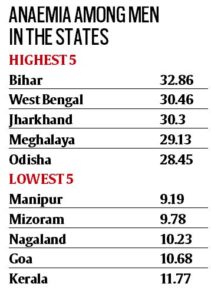Lancet’s Global Burden of Disease Study – Major findings 12/11/2019 – Posted in: Daily News – Tags: anaemia, Diarrhoea, Disability-adjusted life years (DALYs), NCDs (non-communicable diseases), Tuberculosis, YLLs (years of life lost)
Global Burden of Disease Study
For: Preliminary & Mains
Topics covered:
- Key findings of the study
- About National Burden Estimates
- About Anaemia
- About Disability-adjusted life years (DALYs)
News Flash
The Northeastern states along with Uttar Pradesh, Rajasthan, Assam, Gujarat, West Bengal, Haryana, Kerala, Karnataka and Madhya Pradesh account for 44 percent of India’s cancer burden, an analysis of the disease burden data has found.
The analysis, published in The Lancet Global Health, looked at about 9.7 million deaths in India in 2017 and investigated reasons for 486 million disability-adjusted life years (DALYs) in the country.
Among NCDs (non-communicable diseases), cancer YLLs (years of life lost) were particularly high in northeastern states, Uttar Pradesh, Rajasthan, West Bengal, Haryana, Assam, Gujarat and Madhya Pradesh, and in the southern states of Kerala and Karnataka.
Top 10 conditions that caused death and disability in the country that year were:
- Ischaemic heart disease (9.6% of all DALYs)
- Perinatal conditions (8.5%)
- Chronic respiratory diseases (5.7%)
- Diarrhoea (4.7%)
- Respiratory infections (4.5%)
- Cancer (4%)
- Stroke (3.6%)
- Road traffic injuries (3.3%)
- Tuberculosis (3.1%)
- Liver and alcohol-related conditions (3%)
Another major finding
- Nearly a quarter of men in the age group 15-54 had some form of anaemia in India.
- Cases among men ranged from moderate or severe (5.1%) to severe anaemia (0.5%).
- Among age groups, men in the group 20-34 years had the lowest probability of having anaemia, while actual prevalence was lowest in the age group 50-54, at 7.8%.
- The prevalence was higher for younger age groups.
- Among men with anaemia, 21.7% had moderate or severe anaemia; among women with anaemia, 53.2% had moderate or severe anaemia.

National Burden Estimates
NBE is a simple way to enable every country to determine their local burden of disease, what’s killing people and what’s disabling them.
It describes mortality and morbidity from major diseases, injuries and risk factors to health at global, national and regional levels.

Anaemia
Anaemia is a condition in which the number of red blood cells or their oxygen-carrying capacity is insufficient to meet physiological needs, which may vary by age, sex, altitude, smoking and pregnancy status.
Factors such as consuming smokeless tobacco, being underweight, level of urbanisation and household wealth are associated with a higher probability of developing the disease.
Important Information
Disability-adjusted life years (DALYs) are an international unit of death and disability in terms of the number of life-years lost of an average person to death and disability.
Source: Indian Express
READ MORE DAILY NEWS
- Book ‘Courts of India: Past to Present’
- Public Service Broadcasting Day
- 550th birth anniversary of Guru Nanak Dev ji
- First all-electric plane
- World’s First CNG port terminal
- Dal Lake to be declared Eco-sensitive Zone
- World Pneumonia Day – November 12
- National Education Day
You are on the Best Online IAS preparation platform. You are learning under experts.
We are present on Facebook- Diligent IAS, LinkedIn- Diligent IAS, YouTube- Diligent IAS, Instagram- Diligent IAS. Get in touch with us.
